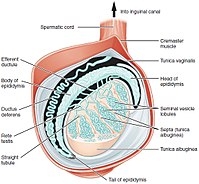
Photo from wikipedia
The hamster is useful for the study of male reproductive biology. However, unlike in the mouse and rat, the gross structure of seminiferous tubules in the hamster is largely unknown.… Click to show full abstract
The hamster is useful for the study of male reproductive biology. However, unlike in the mouse and rat, the gross structure of seminiferous tubules in the hamster is largely unknown. The aim of the present study was to clarify the precise 3‐dimensional (3D) structure of seminiferous tubules in hamsters. We reconstructed all seminiferous tubules in 3 and 1 testes from 0‐day (P0) and 10‐week (adult) Syrian hamsters, respectively, using serial paraffin sections and high‐performance 3D reconstruction software. In P0 hamsters, the average numbers of seminiferous tubules, terminating points, branching points, and blind ends per testis were 9.0, 89.7, 93.0, and 0.7, respectively. There were two types of tubules: shorter and dominant ones. The dominant tubules, 2–4 in number per testis and accounting for 86% of the total tubule length, had many terminating and branching points and appeared to be derived from the anastomosis of many shorter tubules. In an adult hamster, there were 11 seminiferous tubules with a total length of 22 m, 98 terminating points, 88 branching points, and 2 blind ends per testis. Three of the 11 tubules were dominant ones, accounting for 83% of the total length, and occupied the testis from the surface over the circumference to the center, while the others were short and occupied only one side of the testis. The amplitude and direction of the curves of tubules were random, and there were no funnel‐shaped networks of tubules present, in contrast to the mouse testis. The present study revealed the 3D structure of seminiferous tubules in developing and adult Syrian hamsters, which is different from that in mice and rats.
Journal Title: Journal of Anatomy
Year Published: 2020
Link to full text (if available)
Share on Social Media: Sign Up to like & get
recommendations!